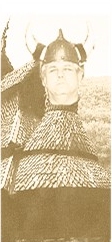The Legend of the Viking Prince
The legend of the Viking Prince lives on in Nordic history as one of the most baffling and complex Archeological mysteries of the twenty-first century.
 |
To the left we see an early daguerreotype taken circa 1831 by a Louis Daguerre which shows the Viking Prince Mjikle's characterture atop the ancient Norsk Hoven Temple in Gjoatnesten. The temple's location remains a mystery today. |
|
||
 |
Often described as the helping hands of history, the Viking
tradition of pillaging and plundering is the darker side of a proud tradition of hospitality and kindness. Today
Norsk tourism and culture thrive. Goat cheese, rock super stars "Ah-Ha" and grog remain the regions mainstay exports and source of income. |
|
||
| The history of Mjikle's trek to the New World inspired much controversy among Norse history purists, some of whom still feel the trans-Atlantic crossing was by ship. |
Photo courtesy of the Nordic Institute of Ancient History. |
Meeting in Oslo in the summer of 2002, anthropologists presented evidence that the actual crossing was via an electric streetcar (trolley) by way of the Arctic circle and Canada. Photo to the left proves this theory. | ||
| If the theory of an electric streetcar Atlantic crossing is to hold water, than the power source to accommodate such should be examined. | Several theories exist, the most popular is the 200 kilometer electric extension cord. While a Herculean task, the length of this theory is a stretch, as was the cord. | Professor Bjorrn Tobe Wilde, of Oslo University believes a system of rechargeable batteries and crude solar cells were used. He insists the length and use of a cord was a violation of the National Electrical Code. | ||
| Return to Mike's Homepage |